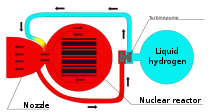Nuclear thermal rocket
A nuclear thermal rocket (NTR) is a type of thermal rocket where the heat from a nuclear reaction, often nuclear fission, replaces the chemical energy of the propellants in a chemical rocket. In an NTR, a working fluid, usually liquid hydrogen, is heated to a high temperature in a nuclear reactor and then expands through a rocket nozzle to create thrust. The external nuclear heat source theoretically allows a higher effective exhaust velocity and is expected to double or triple payload capacity compared to chemical propellants that store energy internally.
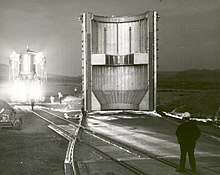
NTRs have been proposed as a spacecraft propulsion technology, with the earliest ground tests occurring in 1955. The US maintained an NTR development program through 1973, when it was shut down to focus on Space Shuttle development. Although more than ten reactors of varying power output have been built and tested, as of 2019, no nuclear thermal rocket has flown.[1]
Nuclear power in space applications that have flown include the fission-electric SNAP-10A and TOPAZ series satellites and radioisotope thermoelectric generators.
Whereas all early applications for nuclear thermal rocket propulsion used fission processes, research in the 2010s has moved to fusion approaches. The Direct Fusion Drive project at the Princeton Plasma Physics Laboratory is one such example, although "energy positive fusion has remained elusive". In 2019, the US Congress approved US$125 million in development funding for nuclear thermal propulsion rockets.[1]
Nuclear fuel types
A nuclear thermal rocket can be categorized by the type of reactor, ranging from a relatively simple solid reactor up to the much more difficult to construct but theoretically more efficient gas core reactor. As with all thermal rocket designs, the specific impulse produced is proportional to the square root of the temperature to which the working fluid (reaction mass) is heated. To extract maximum efficiency, the temperature must be as high as possible. For a given design, the temperature that can be attained is typically determined by the materials chosen for reactor structures, the nuclear fuel, and the fuel cladding. Erosion is also a concern, especially the loss of fuel and associated releases of radioactivity.
Solid core

Solid core nuclear reactors have been fueled by compounds of uranium that exist in solid phase under the conditions encountered and undergo nuclear fission to release energy. Flight reactors must be lightweight and capable of tolerating extremely high temperatures, as the only coolant available is the working fluid/propellant.[1] A nuclear solid core engine is the simplest design to construct and is the concept used on all tested NTRs.
A solid core reactor's performance is ultimately limited by the material properties, including melting point, of the materials used in the nuclear fuel and reactor pressure vessel. Nuclear reactions can create much higher temperatures than most materials can typically withstand, meaning that much of the potential of the reactor cannot be realized. Additionally, with cooling being provided by the propellant only all of the decay heat remaining after reactor shutdown must be radiated to space, a slow process that will expose the fuel rods to extreme temperature stress. During operation, temperatures at the fuel rod surfaces range from the 22 K of admitted propellant up to 3000 K at the exhaust end. Taking place over the 1.3 m length of a fuel rod, this is certain to cause cracking of the cladding if the coefficients of expansion are not precisely matched in all the components of the reactor.
Using hydrogen as a propellant, a solid core design would typically deliver specific impulses (Isp) on the order of 850 to 1000 seconds, which is about twice that of liquid hydrogen-oxygen designs such as the Space Shuttle main engine. Other propellants have also been proposed, such as ammonia, water or LOX, but these propellants would provide reduced exhaust velocity and performance at a marginally reduced fuel cost. Yet another mark in favor of hydrogen is that at low pressures it begins to dissociate at about 1500 K, and at high pressures around 3000 K. This lowers the mass of the exhaust species, increasing Isp.
Early publications were doubtful of space applications for nuclear engines. In 1947, a complete nuclear reactor was so heavy that solid core nuclear thermal engines would be entirely unable[2] to achieve a thrust-to-weight ratio of 1:1, which is needed to overcome the gravity of the Earth at launch. Over the next twenty-five years U.S. nuclear thermal rocket designs eventually reached thrust-to-weight ratios of approximately 7:1. This is still a much lower thrust-to-weight ratio than what is achievable with chemical rockets, which have thrust-to-weight ratios on the order of 70:1. Combined with the large tanks necessary for liquid hydrogen storage, this means that solid core nuclear thermal engines are best suited for use in orbit outside Earth's gravity well, not to mention avoiding the radioactive contamination that would result from atmospheric use.[1]
| Wikimedia Commons has media related to Particle Bed Reactor. |
One way to increase the working temperature of the reactor is to change the nuclear fuel elements. This is the basis of the particle-bed reactor, which is fueled by a number of (typically spherical) elements which "float" inside the hydrogen working fluid. Spinning the entire engine could prevent fuel element from being ejected out the nozzle. This design is thought to be capable of increasing the specific impulse to about 1000 seconds (9.8 kN·s/kg) at the cost of increased complexity. Such a design could share design elements with a pebble-bed reactor, several of which are currently generating electricity. From 1987 through 1991, the SDI Office funded Project Timberwind, a non-rotating nuclear thermal rocket based on particle bed technology. The project was canceled before testing.
Pulsed nuclear thermal rocket
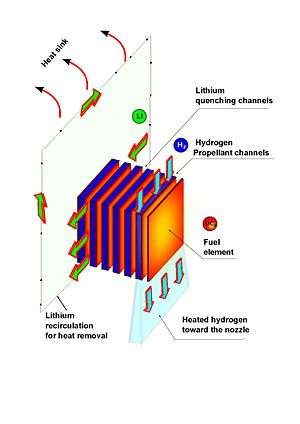
The pulsed nuclear thermal rocket (not to be confused with nuclear pulse propulsion, which is a hypothetical method of spacecraft propulsion that uses nuclear explosions for thrust) is a type of solid nuclear thermal rocket for thrust and specific impulse (Isp) amplification.[3] In this concept, the conventional solid fission NTR can operate in a stationary as well as in a pulsed mode, much like a TRIGA reactor. Because the residence time of the propellant in the chamber is short, an important amplification in energy is attainable by pulsing the nuclear core, which can increase the thrust via increasing the propellant mass flow. However, the most interesting feature is the capability to obtain very high propellant temperatures (higher than the fuel) and then high amplification of exhaust velocity. This is because, in contrast with the conventional stationary solid NTR, propellant is heated by the intense neutron flux from the pulsation, which is directly transported from the fuel to the propellant as kinetic energy. By pulsing the core it is possible to obtain a propellant hotter than the fuel. However, and in clear contrast with classical nuclear thermal rockets (including liquid and gas nuclear rockets), the thermal energy from the decay of fission daughters is unwanted.
Very high instantaneous propellant temperatures are hypothetically attainable by pulsing the solid nuclear core, only limited by the rapid radiative cooling after pulsation.
Liquid core
Liquid core nuclear engines are fueled by compounds of fissionable elements in liquid phase. A liquid-core engine is proposed to operate at temperatures above the melting point of solid nuclear fuel and cladding, with the maximum operating temperature of the engine instead being determined by the reactor pressure vessel and neutron reflector material. The higher operating temperatures would be expected to deliver specific impulse performance on the order of 1300 to 1500 seconds (12.8–14.8 kN·s/kg).
A liquid-core reactor would be extremely difficult to build with current technology. One major issue is that the reaction time of the nuclear fuel is much longer than the heating time of the working fluid. If the nuclear fuel and working fluid are not physically separated, this means that the fuel must be trapped inside the engine while the working fluid is allowed to easily exit through the nozzle. One possible solution is to rotate the fuel/fluid mixture at very high speeds to force the higher density fuel to the outside, but this would expose the reactor pressure vessel to the maximum operating temperature while adding mass, complexity, and moving parts.
An alternative liquid-core design is the nuclear salt-water rocket. In this design, water is the working fluid and also serves as the neutron moderator. The nuclear fuel is not retained which drastically simplifies the design. However, the rocket would discharge massive quantities of extremely radioactive waste and could only be safely operated well outside the Earth's atmosphere and perhaps even entirely outside earth's magnetosphere.
Gas core
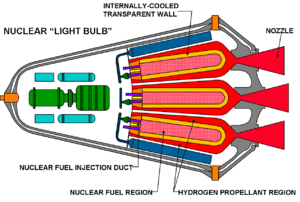
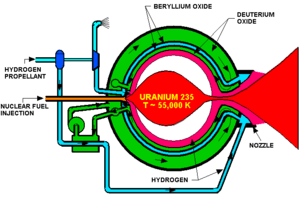
The final fission classification is the gas-core engine. This is a modification to the liquid-core design which uses rapid circulation of the fluid to create a toroidal pocket of gaseous uranium fuel in the middle of the reactor, surrounded by hydrogen. In this case the fuel does not touch the reactor wall at all, so temperatures could reach several tens of thousands of degrees, which would allow specific impulses of 3000 to 5000 seconds (30 to 50 kN·s/kg). In this basic design, the "open cycle", the losses of nuclear fuel would be difficult to control, which has led to studies of the "closed cycle" or nuclear lightbulb engine, where the gaseous nuclear fuel is contained in a super-high-temperature quartz container, over which the hydrogen flows. The closed cycle engine actually has much more in common with the solid-core design, but this time is limited by the critical temperature of quartz instead of the fuel and cladding. Although less efficient than the open-cycle design, the closed-cycle design is expected to deliver a specific impulse of about 1500–2000 seconds (15–20 kN·s/kg).
Solid core fission designs in practice

Soviet Union and Russia
The Soviet RD-0410 went through a series of tests at the nuclear test site near Semipalatinsk.[4][5]
In October 2018, Russia's Keldysh Research Center confirmed a successful ground test of waste heat radiators for a nuclear space engine, as well as previous tests of fuel rods and ion engines.[6]
United States
Development of solid core NTRs started in 1955 under the Atomic Energy Commission (AEC) as Project Rover, and ran to 1973.[1] Work on a suitable reactor was conducted at Los Alamos National Laboratory and Area 25 in the Nevada Test Site. Four basic designs came from this project: KIWI, Phoebus, Pewee and the Nuclear Furnace. Twenty individual engines were tested, with a total of over 17 hours of engine run time.[7]
When NASA was formed in 1958, it was given authority over all non-nuclear aspects of the Rover program. In order to enable cooperation with the AEC and keep classified information compartmentalized, the Space Nuclear Propulsion Office (SNPO) was formed at the same time. The 1961 NERVA program was intended to lead to the entry of nuclear thermal rocket engines into space exploration. Unlike the AEC work, which was intended to study the reactor design itself, NERVA's goal was to produce a real engine that could be deployed on space missions. The 75,000 lbf (334 kN) thrust baseline NERVA design was based on the KIWI B4 series.
Tested engines included Kiwi, Phoebus, NRX/EST, NRX/XE, Pewee, Pewee 2 and the Nuclear Furnace. Progressively higher power densities culminated in the Pewee.[7] Tests of the improved Pewee 2 design were cancelled in 1970 in favor of the lower-cost Nuclear Furnace (NF-1), and the U.S. nuclear rocket program officially ended in spring of 1973. During this program, the NERVA accumulated over 2 hours of run time, including 28 minutes at full power.[1] The SNPO considered NERVA to be the last technology development reactor required to proceed to flight prototypes.
A number of other solid-core engines have also been studied to some degree. The Small Nuclear Rocket Engine, or SNRE, was designed at the Los Alamos National Laboratory (LANL) for upper stage use, both on uncrewed launchers as well as the Space Shuttle. It featured a split-nozzle that could be rotated to the side, allowing it to take up less room in the Shuttle cargo bay. The design provided 73 kN of thrust and operated at a specific impulse of 875 seconds (8.58 kN·s/kg), and it was planned to increase this to 975 seconds, achieving a mass fraction of about 0.74, comparing with 0.86 for the SSME, one of the best conventional engines.
A related design that saw some work, but never made it to the prototype stage, was Dumbo. Dumbo was similar to KIWI/NERVA in concept, but used more advanced construction techniques to lower the weight of the reactor. The Dumbo reactor consisted of several large barrel-like tubes which were in turn constructed of stacked plates of corrugated material. The corrugations were lined up so that the resulting stack had channels running from the inside to the outside. Some of these channels were filled with uranium fuel, others with a moderator, and some were left open as a gas channel. Hydrogen was pumped into the middle of the tube, and would be heated by the fuel as it traveled through the channels as it worked its way to the outside. The resulting system was lighter than a conventional design for any particular amount of fuel.
Between 1987 and 1991 an advanced engine design was studied under Project Timberwind, under the Strategic Defense Initiative, which was later expanded into a larger design in the Space Thermal Nuclear Propulsion (STNP) program. Advances in high-temperature metals, computer modelling and nuclear engineering in general resulted in dramatically improved performance. While the NERVA engine was projected to weigh about 6,803 kg, the final STNP offered just over 1/3 the thrust from an engine of only 1,650 kg by improving the Isp to between 930 and 1000 seconds.
In 2019, an appropriation bill passed by the US Congress included US$125 million[1] in funding for nuclear thermal propulsion research, including planning for a flight demonstration mission by 2024.[8]
Test firings
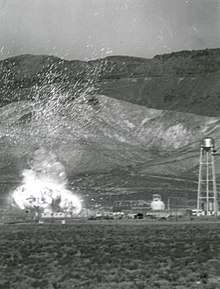
KIWI was the first to be fired, starting in July 1959 with KIWI 1. The reactor was not intended for flight and named after the flightless bird. The core was simply a stack of uncoated uranium oxide plates onto which the hydrogen was dumped. A thermal output of 70 MW at an exhaust temperature of 2683 K was generated. Two additional tests of the basic concept, A1 and A3, added coatings to the plates to test fuel rod concepts.
The KIWI B series were fueled by tiny uranium dioxide (UO2) spheres embedded in a low-boron graphite matrix and coated with niobium carbide. Nineteen holes ran the length of the bundles, through which the liquid hydrogen flowed. On the initial firings, immense heat and vibration cracked the fuel bundles. The graphite materials used in the reactor's construction were resistant to high temperatures but eroded under the stream of superheated hydrogen, a reducing agent. The fuel species was later switched to uranium carbide, with the last engine run in 1964. The fuel bundle erosion and cracking problems were improved but never completely solved, despite promising materials work at the Argonne National Laboratory.
NERVA NRX (Nuclear Rocket Experimental), started testing in September 1964. The final engine in this series was the XE, designed with flight representative hardware and fired into a low-pressure chamber to simulate a vacuum. SNPO fired NERVA NRX/XE twenty-eight times in March 1968. The series all generated 1100 MW, and many of the tests concluded only when the test-stand ran out of hydrogen propellant. NERVA NRX/XE produced the baseline 75,000 lbf (334 kN) thrust that Marshall required in Mars mission plans. The last NRX firing lost 17 kilograms (38 lb) of nuclear fuel in 2 hours of testing, which was judged sufficient for space missions by SNPO.
Building on the KIWI series, the Phoebus series were much larger reactors. The first 1A test in June 1965 ran for over 10 minutes at 1090 MW and an exhaust temperature of 2370 K. The B run in February 1967 improved this to 1500 MW for 30 minutes. The final 2A test in June 1968 ran for over 12 minutes at 4,000 MW, at the time the most powerful nuclear reactor ever built.
A smaller version of KIWI, the Pewee was also built. It was fired several times at 500 MW in order to test coatings made of zirconium carbide (instead of niobium carbide) but Pewee also increased the power density of the system. A water-cooled system known as NF-1 (for Nuclear Furnace) used Pewee 2's fuel elements for future materials testing showing a factor of 3 reduction in fuel corrosion still further. Pewee 2 was never tested on the stand, and became the basis for current NTR designs being researched at NASA's Glenn and Marshall Research Centers.
The NERVA/Rover project was eventually cancelled in 1972 with the general wind-down of NASA in the post-Apollo era. Without a human mission to Mars, the need for a nuclear thermal rocket is unclear. Another problem would be public concerns about safety and radioactive contamination.
Kiwi-TNT destructive test
In January 1965, the U.S. Rover program intentionally modified a Kiwi reactor (KIWI-TNT) to go prompt critical, resulting in an immediate destruction of the reactor pressure vessel, nozzle, and fuel assemblies. Intended to simulate a worst-case scenario of a fall from altitude into the ocean, such as might occur in a booster failure after launch, the resulting release of radiation would have caused fatalities out to 600 feet (183 meters) and injuries out to 2000 feet (610 meters). The reactor was positioned on a railroad car in the Jackass Flats area of the Nevada Test Site.[9]
United Kingdom
As of January 2012, the propulsion group for Project Icarus was studying an NTR propulsion system.[10]
Current research
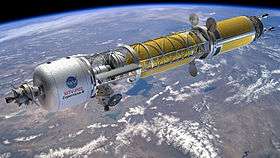
Current solid-core nuclear thermal rocket designs are intended to greatly limit the dispersion and break-up of radioactive fuel elements in the event of a catastrophic failure.[11]
As of 2013, an NTR for interplanetary travel from Earth orbit to Mars orbit being studied at Marshall Space Flight Center.[12] In historical ground testing, NTRs proved to be at least twice as efficient as the most advanced chemical engines, which would allow quicker transfer time and increased cargo capacity. The shorter flight duration, estimated at 3–4 months with NTR engines,[13] compared to 6–9 months using chemical engines,[14] would reduce crew exposure to potentially harmful and difficult to shield cosmic rays.[15][16][17][18] NTR engines, such as the Pewee of Project Rover, were selected in the Mars Design Reference Architecture (DRA).[16][17][19][20] In 2017 NASA continued research and development on NTRs, designing for space applications with civilian approved materials, with a three-year, $18.8-million contract.[21]
Risks
An atmospheric or orbital rocket failure could result in the dispersal of radioactive material into the environment. A collision with orbital debris, material failure due to uncontrolled fission, material imperfections or fatigue, or human design flaws could cause a containment breach of the fissile material. Such a catastrophic failure while in flight could release radioactive material over the Earth in a wide and unpredictable area. The amount of contamination would depend on the size of the nuclear thermal rocket engine, while the zone of contamination and its concentration would be dependent on prevailing weather and orbital parameters at the time of re-entry.
It is considered unlikely that a reactor's fuel elements would be spread over a wide area, as they are composed of materials such as carbon composites or carbides and are normally coated with zirconium hydride. Before criticality occurs, solid core NTR fuel is not particularly hazardous. Once the reactor has been started for the first time, extremely radioactive short-life fission products are produced, as well as less radioactive but extremely long-lived fission products. Additionally, all engine structures are exposed to direct neutron bombardment, resulting in their radioactive activation.
See also
References
- Cain, Fraser (3 July 2019). "Earth To Mars In 100 Days? The Power Of Nuclear Rockets". Universal Sci. Retrieved 24 August 2019.
The first tests of nuclear rockets started in 1955 with Project Rover at the Los Alamos Scientific Laboratory. The key development was miniaturizing the reactors enough to be able to put them on a rocket. Over the next few years, engineers built and tested more than a dozen reactors of different sizes and power outputs.
- Alvarez, Luis, "There Is No Obvious Or Simple Way To Use Atomic Energy For Space Ships", U.S. Air Services, January 1947, pp. 9-12
- Arias, Francisco. J (2016). "On the Use of a Pulsed Nuclear Thermal Rocket for Interplanetary Travel". 52nd AIAA/SAE/ASEE Joint Propulsion Conference Salt Lake City, UT, Propulsion and Energy, (AIAA 2016-4685). doi:10.2514/6.2016-4685.
- Wade, Mark. "RD-0410". Encyclopedia Astronautica. Archived from the original on 8 April 2009. Retrieved 25 September 2009.
- ""Konstruktorskoe Buro Khimavtomatiky" - Scientific-Research Complex / RD0410. Nuclear Rocket Engine. Advanced launch vehicles". KBKhA - Chemical Automatics Design Bureau. Retrieved 25 September 2009.
- "Russia 'tests' key piece of nuclear space engine to revolutionize long-range missions". RT International. 29 October 2018. Retrieved 11 March 2019.
- Dewar, James. "To The End Of The Solar System: The Story Of The Nuclear Rocket", Apogee, 2003
- "Final fiscal year 2019 budget bill secures $21.5 billion for NASA". SpaceNews. 17 February 2019. Retrieved 14 August 2019.
- Fultyn, R. V. (June 1968). "Environmental Effects of the Kiwi-TNT Effluent: A Review and Evaluation" (PDF). LA Reports: U.S. Atomic Energy Commission. Los Alamos: 1–67. PMID 5695558. LA-3449. (Pages 35-36 contain the cited material.)
- Paul Gilster (26 January 2012). "Project Bifrost: Return to Nuclear Rocketry". Retrieved 5 July 2019.
- "Recent Activities at the Center for Space Nuclear Research for Developing Nuclear Thermal Rockets" (PDF). Idaho National Laboratory. Inl.gov. Retrieved 12 June 2017.
- "NASA Researchers Studying Advanced Nuclear Rocket Technologies". space-travel.com.
- Brian Fishbine, Robert Hanrahan, Steven Howe, Richard Malenfant, Carolynn Scherer, Haskell Sheinberg, and Octavio Ramos Jr. (December 2016). "Nuclear Rockets: To Mars and Beyond". National Security Science. Los Alamos National Laboratory.CS1 maint: uses authors parameter (link)
- "How long would a trip to Mars take?". NASA.
- "How Fast Could (Should) We Go to Mars? Comparing Nuclear Electric Propulsion (NEP) with the Nuclear Thermal Rocket (NTR) and Chemical Rocket for Sustainable 1-year human Mars round-trip mission".
- Laura M. Burke, Stanley K. Borowski, David R. McCurdy and Thomas Packard. A One-year Round Trip Crewed Mission to Mars using Bimodal Nuclear Thermal and Electric Propulsion (BNTEP). 49th AIAA/ASME/SAE/ASEE Joint Propulsion Conference San Jose, CA. ARC. doi:10.2514/6.2013-4076.CS1 maint: uses authors parameter (link)
- Borowski, Stanley K.; McCurdy, David R.; Packard, Thomas W. (9 April 2012). "Nuclear Thermal Propulsion (NTP): A Proven Growth Technology for Human NEO / Mars Exploration Missions" (PDF). NASA.
- Borowski, Stanley K.; McCurdy, David R.; Packard, Thomas W. (16 August 2012). "Nuclear Thermal Rocket/Vehicle Characteristics And Sensitivity Trades For NASA's Mars Design Reference Architecture (DRA) 5.0 Study" (PDF). NASA.
- Chris Bergin (24 January 2012). "SLS Exploration Roadmap evaluations provide clues for human Mars missions". NASASpaceFlight.com. Retrieved 26 January 2012.
- Rick Smith for Marshall Space Flight Center, Huntsville AL (SPX) (10 January 2013). "NASA Researchers Studying Advanced Nuclear Rocket Technologies".
- "NASA Contracts with BWXT Nuclear Energy to Advance Nuclear Thermal Propulsion Technology. Aug 2017".
External links
| Wikimedia Commons has media related to Nuclear rocket engines. |
